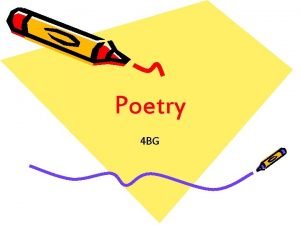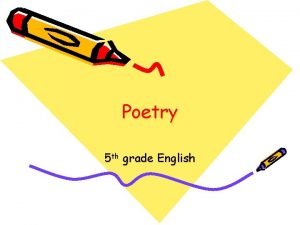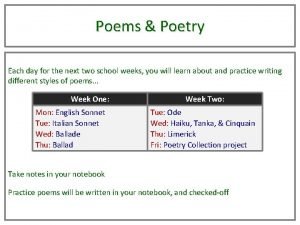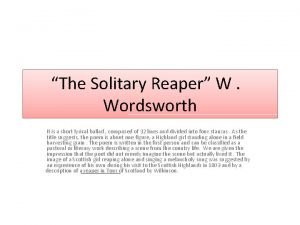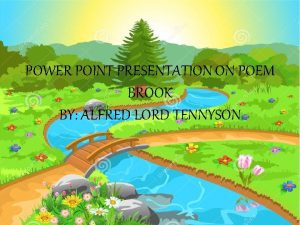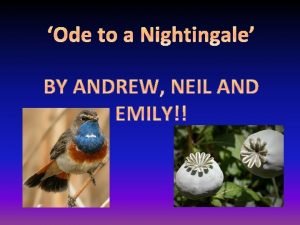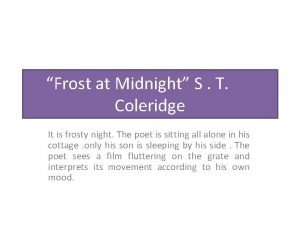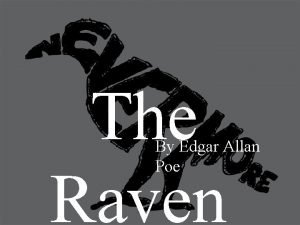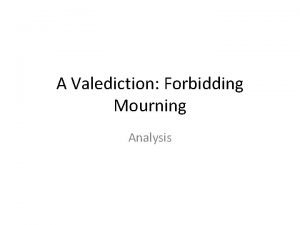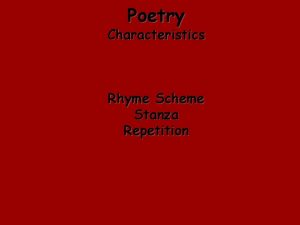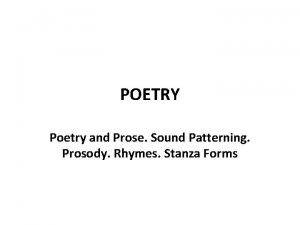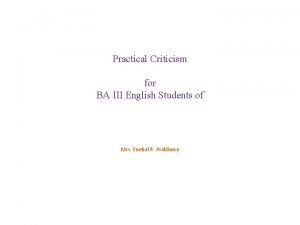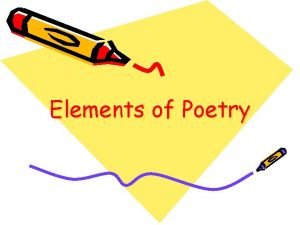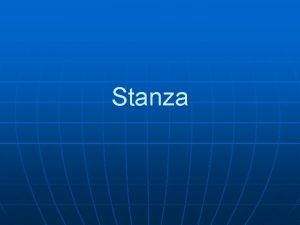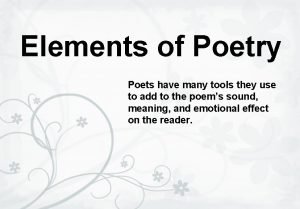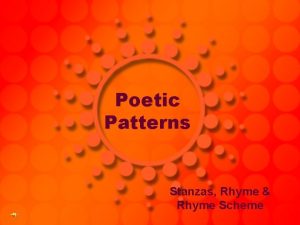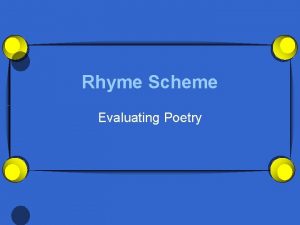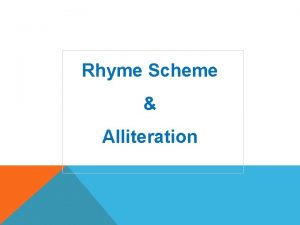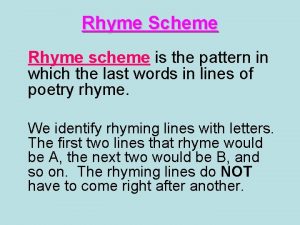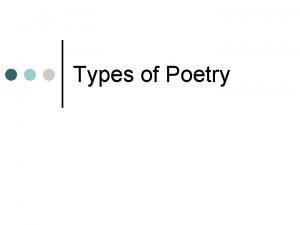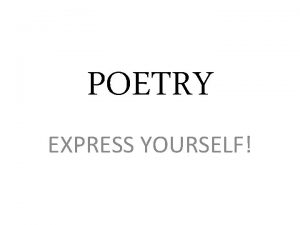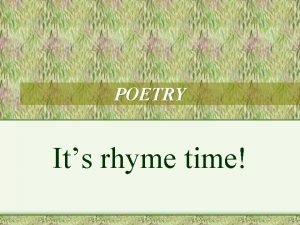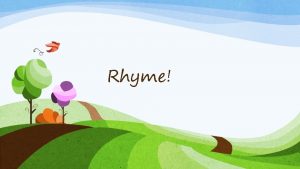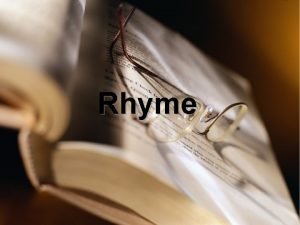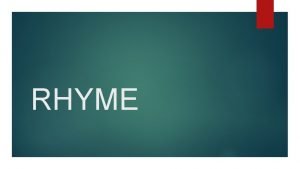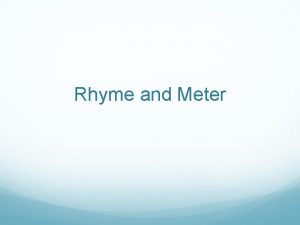Poetry Characteristics Rhyme Scheme Stanza Repetition Standards Demonstrate

















- Slides: 17

Poetry Characteristics Rhyme Scheme Stanza Repetition

Standards Demonstrate the ability to identify elements of poetry such as rhyme scheme, refrain, and stanza. Demonstrate the ability to draw conclusions and make inferences. Demonstrate the ability to identify the author’s purpose in a variety of texts. Demonstrate the ability to write and publish in a variety of formats.

Poetry Vocabulary n Stanza – A stanza is a set of lines in a poem, set apart from other stanzas by space – Stanzas are like paragraphs in a story – Poems without any line breaks are considered single stanza n Rhyme Scheme – Rhyme scheme is the pattern of lines in a poem that rhyme. – Usually letters are used to note which lines rhyme

Stanza Let’s look at the poem and see how the lines in the poem go together like sentences of a paragraph “go together”. Two little caterpillars had a race Down the middle of a long dirt trail. One was as fast as molasses. The other was as quick as a snail. They started out in early morning— Moved a quarter inch by noon. By the time they’d gotten twenty feet They’d turned into cocoons. How many stanzas do you see?

How many stanzas? Class Dismissed (sing to the tune of "The Battle Hymn of the Republic") We have broken all the blackboards so the teachers cannot write. We have painted all the toilets black and all the lockers white. We have torn up all the math books and we've locked the school's front door. There won't be school no more. Glory, glory hallelujah! School is closed now, what's it to ya? There won't be no more homework and there won't be no more tests. There won't be school no more.

Rhyming Poetry Click to find links to find poems with definite rhyme schemes. As you read, make note of the number of stanzas as well. 1 st Use your comprehension strategies as you read. 2 nd 3 rd

Repetition n Repetition is used to make an impact on the poem’s tone. Words or phrases are repeated throughout the poem. n Here comes summer, Chirping robin, budding rose. Here comes summer, Gentle showers, summer clothes. n By Shel Silverstein n n

Repetition Inside the house (I get ready) Inside the car (I go to school) Inside the school (I wait for the bell to ring) By Jake Under I see fish. Inside the waves I hear a splash. Inside the water I felt a fish. It seems so big, as big as a whale. It has to be, But then I see, It's a tuna fish. By Rachel Under the clouds, Under the trees, Under the sea, I can fall asleep, and dream of moving clouds and swaying trees, and waves moving, in the sea. By Rachael

Can you find the repetition? I Love You Not I love you so well, If I had a skunk I would give you a smell. If I were a bathtub I'd give you a splash. If I were a fungus I'd give you a rash. If I were a dog I would give you a bite. If I were a witch I would give you a fright. I love you so much that I won't tell a lie: I promise we'll marry the day that I die.

Repetitions There are many ways to use repetition in a poem: 1. Choose one word (e. g. nose, which can also be knows or nose) and use it at least ten times. It's good to use a word that sounds the same but is spelled differently and has different meanings. 2. Repeat the same word or words at the beginning of each line. E. g. Someday I will, Can you hear, You will be, When I am - these are simple ones. 3. Write a line that can act as a refrain, then use it three or four times throughout the poem

Poetic Terminology n Refrain – A refrain is a set of repeated lines at intervals throughout the poem – If songs are considered poems, the refrain, or chorus, is usually the first part that you learn because you hear it so many times while the song is playing.

Poems with Refrains n The linked poems each have refrains. n How do you think the refrain adds to the poem?

Putting It All Together n Use your reading comprehension strategies to understand the poems as you read them.

Lengths of Time by: Phyllis Mc. Ginley Time is peculiar And hardly exact Though minutes are minutes You’ll find for a fact (As the older you get And the bigger you grow) That time can Hurrylikethis Or plod…. slow. Waiting for dinner when you’re hungry? Down with the sniffles in your bed? Notice how an hour crawls along and crawls along Like a snail with his house upon his head. But when you are starting A game in the park, It’s morning, It’s noon, And suddenly it’s dark. And hours like seconds Rush blurringly by, Whoosh! Like a plane in the sky. 1. The words in the last two lines of the first stanza show that time a. Gets bigger as you grow b. Can pass quickly or slowly c. Can run out d. Sneaks up on you 2. In the second stanza, you’re is a contraction meaning a. You have b. Your c. You are d. You had

3. The purpose of the second stanza is to describe a. Why time changes during the day b. When time moves slowly c. How time races when you are hungry d. When time can disappear. 4. In stanza 3, the author uses the word Whoosh to describe a. Time when you are having fun b. How snails move in their house c. The wind outside the house d. The sound of her sniffles

The Four Seasons by: Jack Prelutsky Summer The earth is warm, the sun’s ablaze, it is a time of carefree days; and bees abuzz that chance to pass may see me snoozing on the grass Fall The leaves are yellow, red, and brown, a shower sprinkles softly down; the air is fragrant, crisp, and cool, and once again I’m stuck in school. Winter The birds are gone, the world is white, the winds are wild, they chill and bite; the ground is thick with slush and sleet, and I can barely feel my feet. Spring The fields are rich with daffodils, a coat of clover cloaks the hills, and I must dance, and I must sing to see the beauty of the spring. 1. The rhyming pattern in each stanza is a. The first and third lines rhyme b. Second and third lines rhyme c. (1 st & 2 nd)and the (3 rd & 4 th ) lines rhyme d. Every line rhymes 2. According to the poem, the author’s favorite season is a. Summer b. Fall c. Spring d. Not really obvious

3. In the second stanza, the words “crisp and cool” appear to the reader’s sense of a. sight b. smell c. touch d. taste 4. In the 4 th stanza of the poem, the author uses the word cloaks to show a. That the clover is scattered on the hills b. That the clover covers the hill completely c. That you can see lots of bare earth on the hills d. That there is a large clump of clover right on top of the hills
 What is mean by rhyme scheme
What is mean by rhyme scheme Poem in english for class 5
Poem in english for class 5 Ode structure examples
Ode structure examples What is the rhyme scheme of the poem
What is the rhyme scheme of the poem Solitary reaper analysis
Solitary reaper analysis By thirty hills i hurry down
By thirty hills i hurry down Ode to a nightingale first stanza analysis
Ode to a nightingale first stanza analysis Frost at midnight line by line explanation
Frost at midnight line by line explanation What is the main message of the raven
What is the main message of the raven The rime of the ancient mariner analysis stanza by stanza
The rime of the ancient mariner analysis stanza by stanza Analisi a valediction forbidding mourning
Analisi a valediction forbidding mourning Poems with repetition and rhyme
Poems with repetition and rhyme Ode of autumn summary
Ode of autumn summary Practical criticism solved examples
Practical criticism solved examples Stanza definition in poetry
Stanza definition in poetry Stanza definition
Stanza definition 1stanza
1stanza 6 line stanza poem
6 line stanza poem
